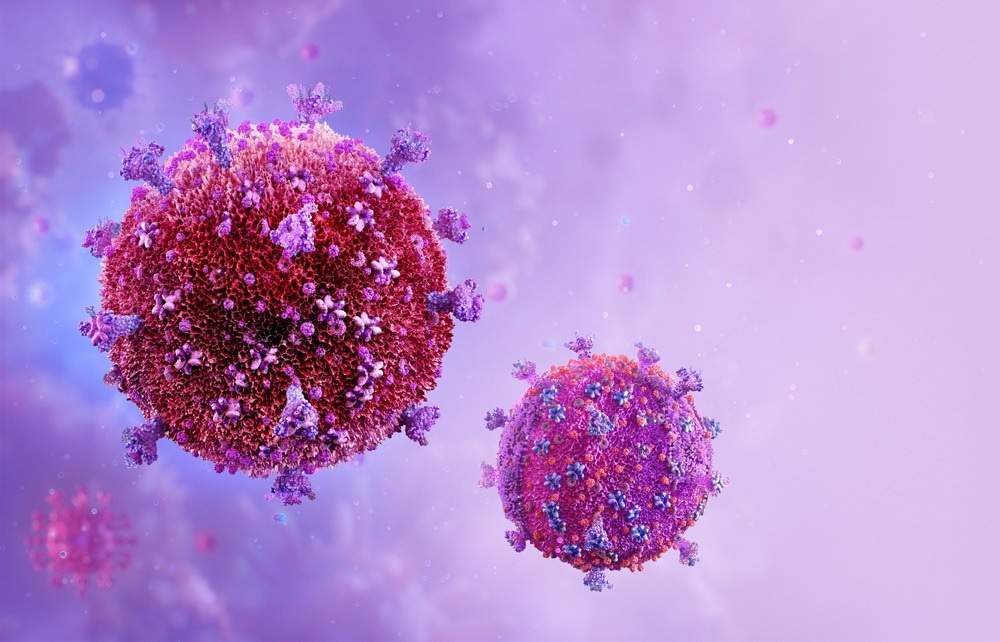In a recent study published in Retrovirology, researchers assessed the effectiveness of severe acute respiratory syndrome coronavirus (SARS-CoV) and SARS-CoV-2 envelope (E) proteins against human immunodeficiency virus (HIV)-1.

Background
Viroporins are ion channels expressed by viruses that play a role in viral assembly and release. Viroporins are encoded by HIV-1 as well as the influenza A virus. The human SARS-CoV-2 encodes for a minimum of two viroporins, including a transmembrane protein with 75 amino acids called the envelope (E) protein and a protein with 275 amino acids called open-reading frame (Orf)-3a.
About the study
In the present study, researchers evaluated HIV-1 replication in the presence of four distinct ꞵ-CoV E proteins.
First, the intracellular expression corresponding to the SARS-CoV-2 E protein was investigated. The team transfected COS-7 cells with a vector encoding the SARS-CoV-2 E protein fused to a hemagglutinin (HA)-tag at the C-terminus and immunostained to detect E protein (anti-HA) while antibodies were directed against the endoplasmic reticulum-Golgi intermediate compartment (ERGIC53), trans Golgi (Golgin97), or late endosomes/lysosomes (LAMP-1).
To examine E protein co-localization with the ER, trans-Golgi network (TGN) and cis-medial Golgi, cells were co-transfected along with plasmids that expressed the E-HA protein with vectors that expressed ER-Mox-green fluorescent protein (GFP) (RER), giantin-GFP, or TGN. During these co-transfections, the team fixed, permeabilized, and immunostained the cells with anti-HA antibody to detect the E protein.
The intracellular distribution of SARS-CoV-2 E was also compared to the E proteins present in SARS-CoV, human CoV (hCoV)-OC43, and Middle East respiratory syndrome (MERS)-CoV. Next, the team determined whether the SARS-CoV-2 E protein would increase or decrease the production of infectious ΔvpuHIV-1 or HIV-1.
HEK293 cells were co-transfected with pcDNA3.1(+) that expressed the SARS-CoV-2 E protein along with HSV-1 glycoprotein D (gD), which served as the positive control for restriction, or gD[ΔTMCT], and pNL4-3. Furthermore, the researchers investigated whether the E protein inhibited ΔvpuHIV-1. The capacity of ΔvpuHIV-1 to multiply in the presence of SARS-CoV-2 E and bone marrow stromal cell antigen 2 (BST-2) proteins were also determined.
Results
The results indicated that the SARS-CoV-2 E protein was co-localized with ER, ERGIC, trans Golgi, cis-medial Golgi, and TGN markers. However, neither the cell plasma membrane nor the lysosomes contained E protein. The intracellular localization observed for the three E proteins was identical to that of the SARS-CoV-2 E protein. In the presence of the SARS-CoV-2 E protein, the amount of infectious HIV-1 released was dramatically reduced. Immunoblots observed for the SARS-CoV-2 E, and gD proteins on cell lysates demonstrated that these proteins were well expressed during co-transfections.
Co-transfection with vectors that expressed BST-2, SARS-CoV-2 E protein, and the ΔvpuHIV-1 genome resulted in a decline in infectious virus generation, although not to the same extent as the HSV-1 gD protein. Immunoblots for the SARS-CoV-2 E protein, gD, Vpu, and BST-2 on cell lysates demonstrated that these proteins were effectively expressed during co-transfections. Collectively, this demonstrated that the SARS-CoV-2 E protein hindered the generation of both viruses and could not replace the Vpu protein.
Similar to the SARS-CoV-2 E protein, investigation of the intracellular expression of the HcoV-OC43, SARS-CoV, and MERS-CoV E proteins indicated that they were mostly localized in the ER and Golgi sections of the cell, with no expression observed at the cell surface. Whi gD inhibited the infectious HIV-1 release, gD [ΔTMCT] showed no such impact. Furthermore, the SARS-CoV and SARS-CoV-2 E proteins inhibited the release of HIV-1 by 1.4% and 1.3%, respectively.
Immunoprecipitation of HIV-1 proteins from lysates generated from cells co-transfected with the vector encoding SARS-CoV-2 E and pNL4-3 indicated that E precursor, namely gp120, gp160, p24, and p55 were immunoprecipitated at significantly lower quantities than p24 and gp120 in the clarified culture media.
Transfection of HEK293 cells with an empty pcDNA3.1(+) vector and subsequent treatment with STS induced considerable caspase 3 activity. SARS-CoV and SARS-CoV-2 E proteins showed the highest amount of caspase 3 activity, followed by HCoV-OC-43 and MERS-CoV E proteins. These findings demonstrated a link between caspase 3 activity and HIV-1 production levels.
Conclusion
Overall, the study findings demonstrated that although viroporins derived from homologous viruses can increase viral release, a viroporin from a heterologous virus can inhibit HIV-1 protein synthesis and virus release.
- Henke, W. et al. (2022) "The envelope proteins from SARS-CoV-2 and SARS-CoV potently reduce the infectivity of human immunodeficiency virus type 1 (HIV-1)", Retrovirology, 19(1). doi: 10.1186/s12977-022-00611-6. https://retrovirology.biomedcentral.com/articles/10.1186/s12977-022-00611-6
Posted in: Medical Science News | Medical Research News | Disease/Infection News
Tags: Antibodies, Antibody, Antigen, Bone, Bone Marrow, Cell, Coronavirus, Coronavirus Disease COVID-19, Fluorescent Protein, Genome, Glycoprotein, HIV, HIV-1, Homologous, Immunodeficiency, Immunoprecipitation, Influenza, Intracellular, Ion, Lysosomes, Membrane, MERS-CoV, Protein, Protein Synthesis, Respiratory, Retrovirology, SARS, SARS-CoV-2, Severe Acute Respiratory, Severe Acute Respiratory Syndrome, Syndrome, Transfection, Virus

Written by
Bhavana Kunkalikar
Bhavana Kunkalikar is a medical writer based in Goa, India. Her academic background is in Pharmaceutical sciences and she holds a Bachelor's degree in Pharmacy. Her educational background allowed her to foster an interest in anatomical and physiological sciences. Her college project work based on ‘The manifestations and causes of sickle cell anemia’ formed the stepping stone to a life-long fascination with human pathophysiology.
Source: Read Full Article
